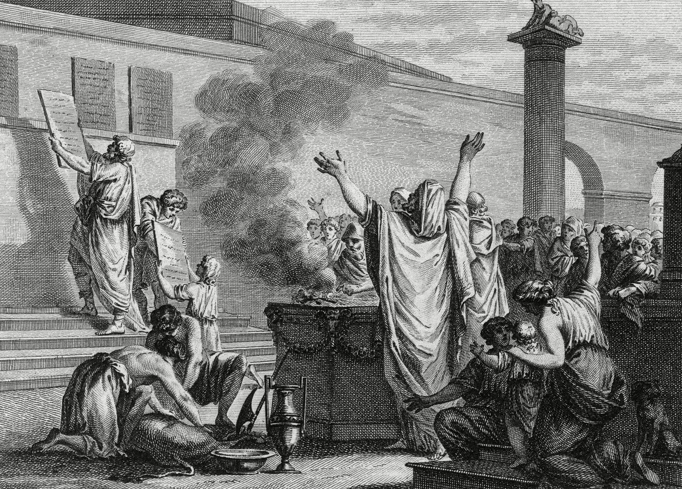Uncovering the Ancient Roots of Modern Law: Exploring the Influence of Roman Law
Contents
- History of Roman Law
- Key Concepts in Roman Law
- Influence on Modern Legal Systems
- Conclusion
-
Frequently Asked Questions
- 1. What is Roman law and how did it evolve?
- 2. What were the key characteristics of early Roman law?
- 3. Who was Emperor Justinian and what was his contribution to Roman law?
- 4. What is the concept of justice in Roman law?
- 5. How were legal interpretations made in Roman law?
- 6. What were the different types of contracts in Roman law?
- 7. How were property rights protected in Roman law?
- 8. How did Roman law influence European legal systems?
- 9. How did Roman law impact common law systems?
- 10. How did Roman law shape civil law systems?
- References
-
Frequently Asked Questions
- 1. How did Roman law develop over time?
- 2. What was the significance of Justinian’s Corpus Juris Civilis?
- 3. What is the concept of justice in Roman law?
- 4. How did Roman law approach the interpretation of laws?
- 5. What were the key elements of Roman contract law?
- 6. How did Roman law protect property rights?
- 7. How did Roman law influence legal systems in Europe?
- 8. In what ways did Roman law adapt in common law systems?
- 9. How has Roman law impacted civil law systems?
- 10. What is the legacy of Roman law in modern legal systems?
- References
- Read More
History of Roman Law

Roman law has a rich and fascinating history that spans over a thousand years. Its origins can be traced back to the early days of the Roman Republic, when customary laws and legal codes were developed to govern the growing society. However, it was during the reign of Emperor Justinian in the 6th century AD that Roman law reached its pinnacle with the creation of the Corpus Juris Civilis, a comprehensive compilation of legal principles and statutes. This monumental work not only preserved the ancient Roman legal system but also laid the groundwork for modern legal systems around the world. From its humble beginnings to its enduring legacy, the history of Roman law continues to captivate scholars and legal enthusiasts alike. (For more information on compatibility, check out this article on Sagittarius and Aries rising compatibility.)
Early Roman Law
Early Roman law refers to the legal system that emerged during the early days of the Roman Republic. It was a time characterized by the gradual development of legal norms and customs that would later form the basis of Roman law. At this stage, the legal system was largely unwritten and was based on social customs and traditional practices. It relied heavily on the patrician class, who held significant influence in legal matters. The early Roman law focused primarily on matters of property, inheritance, and contracts. Disputes and conflicts were resolved through the intervention of a mediator or an “arbiter”. These arbiters were chosen by the parties involved and were responsible for rendering a fair decision based on customary practices.
Over time, a body of legal principles began to emerge, which shaped the early Roman law. One of the significant contributions during this period was the establishment of the Twelve Tables in 450 BC. These tables were the first written laws in Rome and provided a foundation for the legal system. They covered various aspects of law, including property rights, family law, and criminal offenses. The Twelve Tables aimed to ensure equal treatment under the law, protect individual rights, and uphold social order.
During this era, legal proceedings were primarily conducted orally, and there were no professional lawyers. Instead, individuals represented themselves in court, presenting their case directly to the magistrate or judge. The magistrate’s role was crucial in interpreting the law and settling disputes.
The early Roman law set the groundwork for the development of a more sophisticated legal system. It laid the foundation for the later codification of laws and the principles that would shape Roman law for centuries to come. (For more information on compatibility, check out this article on Cancer and Capricorn compatibility.)
Justinian and the Corpus Juris Civilis
Emperor Justinian played a pivotal role in the development and preservation of Roman law with his monumental work known as the Corpus Juris Civilis. During his reign in the 6th century AD, Justinian sought to consolidate and codify the vast body of existing Roman laws into a systematic and comprehensive collection. Recognizing the need for reform and clarity, he commissioned a team of legal scholars to compile and organize the laws that had been established over centuries.
The resulting Corpus Juris Civilis, also known as the Justinian Code, comprised of four major parts: the Codex Justinianus, the Digesta (or Digest), the Institutiones (or Institutes), and the Novellae Constitutiones (or Novels). Each of these components served a unique purpose in preserving and interpreting Roman law.
The Codex Justinianus was a collection of imperial enactments, which included laws, decrees, and legal opinions. It aimed to consolidate and simplify the complex legal system, making it more accessible to both legal professionals and the general public.
The Digesta consisted of extracts from prominent legal scholars dating back to the Republican era. It served as a comprehensive legal encyclopedia, summarizing and analyzing various legal opinions and precedents. The Digesta played a crucial role in providing guidance for legal practitioners when interpreting and applying the law.
The Institutiones was a law textbook designed for students studying law. It served as an introductory guide to Roman law, covering fundamental legal concepts and principles. The Institutiones played a vital role in educating future legal professionals and ensuring the continuity of legal knowledge.
The Novellae Constitutiones comprised of additional laws and regulations issued by Justinian after the completion of the initial three parts of the Corpus Juris Civilis. These novellae served as updates and amendments to the existing legal framework, adapting Roman law to the changing societal and legal landscape of the time.
The Corpus Juris Civilis had a profound and lasting impact on the development of legal systems around the world. Its systematic organization, clarity, and enduring relevance allowed Roman law to continue influencing legal principles and practices for centuries to come. (For more information on fascinating folklore and legends, check out this article on Native American heroic legends and folklore.)
Key Concepts in Roman Law

Key Concepts in Roman Law: Roman law was built on fundamental principles and concepts that shaped its legal system. One of these concepts was the idea of justice, which emphasized fairness and equality before the law. This concept influenced the development of legal systems worldwide. Roman law also emphasized the principles of legal interpretation, such as the use of analogies, maxims, and precedent to interpret and apply the law. Additionally, Roman law recognized the importance of contracts and obligations, establishing rules and regulations for agreements between parties. Another key concept was the recognition of property rights, which outlined rules for ownership, possession, and transfer of property. These key concepts served as the foundation of Roman law and continue to shape legal systems today.
Concept of Justice
The in Roman law played a pivotal role in shaping the legal system of ancient Rome and continues to influence modern legal systems today. Roman law emphasized the idea of equity and fairness in resolving disputes and administering justice. One of the key principles underlying the concept of justice in Roman law was that individuals were entitled to their legal rights and obligations. This meant that every person had the right to be heard and defend themselves in legal proceedings. Additionally, the concept of justice in Roman law focused on the principle of proportionality – that the punishment should be equal to the severity of the crime committed. This idea of proportionality was crucial in maintaining social order and deterring individuals from engaging in unlawful activities. The concept of justice also extended to the idea of restitution, where the injured party was entitled to compensation or damages for any harm suffered. This principle ensured that individuals who suffered losses or damages were adequately compensated. The concept of justice in Roman law was based on the idea that the law should be fair, impartial, and accessible to all citizens. It formed the foundation of a legal system that valued individual rights and sought to uphold justice for the betterment of society as a whole.
Principles of Legal Interpretation
In the vast realm of Roman law, the held a pivotal role in ensuring the fair and consistent application of laws. These principles formed the foundation for interpreting legal texts and resolving disputes. One key principle was the literal interpretation, where the words of the law were given their plain and ordinary meaning. However, the Romans recognized that not all situations could be addressed by the literal interpretation alone. Thus, they developed the principle of equity, which allowed judges to consider the intent and spirit of the law, rather than just the literal wording. This principle aimed to achieve justice and fairness in situations where the strict application of the law could lead to unjust outcomes. Additionally, analogical interpretation was utilized, which involved applying existing legal principles to similar cases. This allowed for consistency in legal decisions and the development of legal precedents. The Romans also emphasized the importance of good faith in legal interpretation, emphasizing that legal texts should be interpreted in a way that is not only fair but also aligned with the intentions of the lawmakers. These principles of legal interpretation laid the groundwork for the modern legal systems we have today, influencing concepts such as statutory interpretation, precedent, and the search for justice and equity in legal proceedings.
Contracts and Obligations
Contracts and obligations played a central role in Roman law, shaping the foundation of modern legal systems. In Roman society, a contract was a legally binding agreement between two parties, creating rights and obligations that had to be upheld. These contracts could cover a wide range of transactions, including the sale of goods, the leasing of property, or the provision of services. Roman law recognized various types of contracts, each with its own set of rules and requirements. For example, a verbal contract involved an oral agreement between parties, while a written contract provided a more formal and documented agreement. A stipulatio was a specific type of verbal contract that required a formal question-and-answer format for agreement. Roman law also emphasized the importance of good faith in contracts, requiring both parties to act honestly and fulfill their obligations. This principle continues to influence modern legal systems, ensuring that contracts are binding and enforceable. Whether it’s buying a house, signing an employment agreement, or entering into a business partnership, the concept of contracts and obligations continues to shape our legal landscape today.
Property Rights
One of the key concepts in Roman law was the recognition and protection of property rights. Roman law recognized both public and private property, distinguishing between res publica (public property) and res privata (private property). Private property rights were highly valued in Roman society and were protected by the legal system. The Romans believed in the concept of ownership, and individuals had the right to possess, use, and dispose of their property as they saw fit. They could transfer ownership through various means, such as sale, gift, or inheritance. The legal framework surrounding property rights in Roman law was built upon the principles of ownership, possession, and acquisition. These principles were enshrined in the Roman legal codes, such as the Twelve Tables, which provided guidelines for resolving disputes related to property ownership and possession. Additionally, the concept of adverse possession was recognized in Roman law, allowing individuals to acquire ownership of property through continuous and uninterrupted possession for a certain period of time. The recognition and protection of property rights in Roman law laid the foundation for modern property law in many legal systems around the world, emphasizing the importance of ownership and the rights of individuals to their possessions.
Influence on Modern Legal Systems

The influence of Roman law on modern legal systems cannot be overstated. Its impact can be seen in both continental European civil law systems and the common law traditions of countries like England and the United States. In European legal systems, Roman law provided a framework for organizing and codifying laws, ensuring continuity and consistency across jurisdictions. The principles of Roman law, such as the concept of justice, legal interpretation, and property rights, have been incorporated into civil codes that still form the basis of legal systems in countries like France, Germany, and Italy. On the other hand, the common law system, with its emphasis on judicial precedent, drew inspiration from Roman legal thinking to develop a system that relies on the interpretation and application of previous court decisions. The lasting legacy of Roman law has shaped the foundation of modern legal systems and continues to guide the practice of law around the world.
Continuity in European Legal Systems
Continuity in European Legal Systems:
The influence of Roman law on European legal systems is strikingly evident in the concept of continuity. Even after the collapse of the Roman Empire, the principles and legal frameworks established by Roman law continued to shape the development of legal systems across Europe. In many European countries, the Roman legal tradition was preserved and adapted over the centuries. For instance, in countries like Germany, France, Italy, and Spain, Roman law forms the foundation of civil law systems. The principles of Roman law, such as the importance of written laws, legal reasoning, and the recognition of individual rights, have endured to this day. The continuity of Roman legal concepts can be observed in various aspects of European legal systems, including the organization of courts, the structure of legal codes, and the emphasis on legal education. The enduring presence of Roman law in European legal systems is a testament to its profound influence and remarkable longevity. (For information on Cancer and Capricorn compatibility, take a look at this article.)
Adaptation in Common Law
Adaptation in Common Law:
– Reception and Incorporation: During the Middle Ages, the principles of Roman law were reintroduced and incorporated into English common law. This process, known as reception, involved the acceptance and implementation of certain Roman legal concepts and doctrines. The reception of Roman law in common law jurisdictions varied, with some areas embracing it more extensively than others.
– Equity and Roman Law: Another significant aspect of the adaptation of Roman law in the common law system was the influence of equity. Equity, a system of legal principles rooted in fairness and justice, developed as a parallel system to common law. It drew inspiration from Roman law concepts such as natural law and equitable remedies, providing a more flexible and equitable approach to legal disputes.
– Contracts and Torts: Roman law’s influence on common law can be seen in the areas of contracts and torts. Roman law provided a systematic approach to contracts, emphasizing the importance of consensus, formalities, and enforceability. Similarly, Roman law principles relating to torts, such as the concept of fault and the duty of care, influenced the development of common law doctrines in these areas.
– Institutional Structures: The adaptation of Roman law in common law jurisdictions also influenced the development of institutional structures. For example, the concept of legal professions and the role of judges as interpreters of law can be traced back to Roman legal practices. Similarly, the hierarchical structure of courts and the division of law into different branches, such as civil and criminal law, have their roots in Roman law concepts.
The adaptation of Roman law in the common law system was not a wholesale adoption, but rather a selective incorporation of principles and concepts that aligned with existing legal traditions. This process of adaptation contributed to the evolution and development of the common law system, enriching it with the wisdom and insights of Roman legal thought.
Impact on Civil Law Systems
The impact of Roman law on civil law systems cannot be overstated. Civil law systems, which are based on codified laws and legal principles, have been heavily influenced by the concepts and structure of Roman law. The Roman legal framework provided a solid foundation for civil law jurisdictions, shaping their legal systems in terms of structure, methodology, and concepts. One of the key aspects of Roman law that has had a profound impact on civil law systems is its emphasis on legal certainty and predictability. The Roman legal system sought to provide clear and unambiguous laws that would guide individuals and ensure fair and consistent outcomes. This emphasis on certainty and predictability can be seen in modern civil law systems, where laws are codified and judges are bound by precedent. Additionally, the Roman concept of juristic persons, or legal entities with legal rights and responsibilities, has been incorporated into civil law systems. This allows for the recognition and protection of legal entities such as corporations and organizations. The Roman law principle of equity, which focuses on fairness and justice, continues to influence civil law systems. Civil law jurisdictions often have mechanisms in place to ensure equitable outcomes, especially in cases where strict application of the law may lead to unjust results. These are just a few examples of the lasting impact of Roman law on civil law systems, showcasing how an ancient legal system continues to shape the modern world.
Conclusion

Conclusion
The influence of Roman law on modern legal systems is undeniable. Through its evolution and adaptation, Roman law laid the foundation for the legal principles and concepts that form the basis of many legal systems around the world. From the early days of the Roman Republic to the comprehensive compilation of the Corpus Juris Civilis under Emperor Justinian, Roman law has shaped the way we understand justice, legal interpretation, contracts, obligations, and property rights.
In European legal systems, the continuity of Roman law can be seen in the civil law tradition, which draws heavily from Roman legal principles. The Civil Law systems, prevalent in countries like France, Germany, and Italy, continue to incorporate Roman law concepts into their legal frameworks to this day.
The impact of Roman law is also evident in the development of common law systems, particularly in countries like England and the United States. While common law originated from English law, it has integrated elements of Roman legal principles, especially in the areas of property rights and contracts.
The legacy of Roman law extends beyond Europe and the common law tradition. It has influenced legal systems in regions such as Latin America, where civil law systems prevail. These countries have embraced Roman law principles, adapting and incorporating them into their own legal frameworks.
In conclusion, the influence of Roman law on modern legal systems is far-reaching and profound. Its principles, concepts, and legal frameworks continue to shape the way we administer justice and enforce laws. As we delve into the complexities of modern legal systems, it is essential to recognize and appreciate the enduring legacy of Roman law. Whether in the form of civil law or common law, the foundations of our legal systems owe a debt of gratitude to the ancient Romans and their contribution to the development of modern legal systems.
Frequently Asked Questions

1. What is Roman law and how did it evolve?
Roman law refers to the legal system of ancient Rome, which developed and evolved over several centuries. It began as customary laws and gradually transformed into a comprehensive set of legal principles and statutes under Emperor Justinian.
2. What were the key characteristics of early Roman law?
Early Roman law was characterized by a strong emphasis on tradition, customs, and the concept of natural justice. It relied heavily on the interpretation and application of precedents set by judges.
3. Who was Emperor Justinian and what was his contribution to Roman law?
Emperor Justinian was a Byzantine emperor who reigned from 527 to 565 AD. His most significant contribution was the creation of the Corpus Juris Civilis, a comprehensive compilation of Roman laws, legal principles, and legal procedures.
4. What is the concept of justice in Roman law?
In Roman law, justice was seen as a balance between individual rights and the common good. It aimed to ensure fairness, equality, and the protection of property rights.
5. How were legal interpretations made in Roman law?
Legal interpretations in Roman law were made through the use of various interpretive principles, such as literal interpretation, historical interpretation, and the use of analogy. Judges played a crucial role in interpreting and applying the law.
6. What were the different types of contracts in Roman law?
Roman law recognized various types of contracts, such as sale contracts, loan contracts, and partnership contracts. These contracts were based on the principles of consent, agreement, and mutual obligations.
7. How were property rights protected in Roman law?
Property rights were highly valued in Roman law. The law provided safeguards against theft, trespassing, and unjust acquisition or disposal of property. Legal remedies, such as compensation or restitution, were available to protect property rights.
8. How did Roman law influence European legal systems?
Roman law had a profound influence on European legal systems. It provided a foundation for legal principles and institutions, and its ideas were incorporated into medieval and modern legal systems in Europe.
9. How did Roman law impact common law systems?
Roman law had a significant impact on common law systems, particularly through the reception of Roman legal principles by early English jurists. This influence can be seen in areas such as contract law, property law, and legal reasoning.
10. How did Roman law shape civil law systems?
Roman law directly shaped civil law systems, especially on the European continent. The civil law tradition is rooted in the Roman legal framework, with its focus on codification, legal principles, and the role of judges in interpreting and applying the law.
References
- Importance of the Roman Law: from ancient times to …
- How did Roman law influence modern laws?
- The Contribution of Roman Law to Modern Legal Systems
Frequently Asked Questions

1. How did Roman law develop over time?
Roman law evolved over centuries, starting from the early Roman Republic and continuing through the Roman Empire. It underwent significant expansions and reforms under Emperor Justinian in the 6th century.
2. What was the significance of Justinian’s Corpus Juris Civilis?
Justinian’s Corpus Juris Civilis, or the Body of Civil Law, was a comprehensive compilation of Roman laws. It became the foundation of legal systems in medieval Europe and played a crucial role in the development of modern legal systems.
3. What is the concept of justice in Roman law?
In Roman law, the concept of justice was centered around the idea of giving each person their due. It emphasized fairness, equality, and the protection of individual rights.
4. How did Roman law approach the interpretation of laws?
Roman law prioritized a principle known as “literal interpretation.” Judges aimed to understand the true meaning and intention behind the words of the law, focusing on what was explicitly written.
5. What were the key elements of Roman contract law?
Roman contract law revolved around the principles of agreement, consent, and consideration. It recognized various types of contracts, including sale, lease, loan, and mandate.
6. How did Roman law protect property rights?
Roman law established strong protections for property rights. It recognized a person’s right to acquire, use, and dispose of property, and provided legal remedies against any interference or violation of these rights.
7. How did Roman law influence legal systems in Europe?
Roman law had a profound influence on legal systems in Europe. It provided a common legal language and framework, contributing to the continuity and stability of legal systems throughout the continent.
8. In what ways did Roman law adapt in common law systems?
While common law systems have evolved independently, they were influenced by Roman law concepts such as legal reasoning, precedent, and the importance of written laws. These influences shaped the development of common law.
9. How has Roman law impacted civil law systems?
Civil law systems, prevalent in many countries today, have been directly influenced by Roman law. They adopted Roman legal principles, such as codification, legal certainty, and the separation of public and private law.
10. What is the legacy of Roman law in modern legal systems?
The legacy of Roman law in modern legal systems includes its lasting influence on legal principles, concepts, and institutions. It laid the foundation for the development of legal systems worldwide, contributing to the rule of law and the protection of individual rights.
References
- How did Roman law influence modern laws?
- The Contribution of Roman Law to Modern Legal Systems
- Roman law







